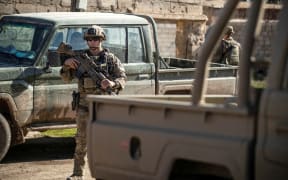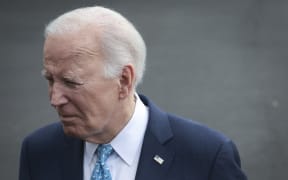By Paul Adams, for BBC

The United States carried out retaliatory airstrikes on Friday in Iraq and Syria against more than 85 targets linked to Iran's Revolutionary Guard (IRGC) and the militias it backs. Photo: KEVIN DIETSCH / Getty Images via AFP
Analysis - As expected, Friday night's US strikes were carefully calibrated, going further than the US has gone in Iraq and Syria in recent months - but stopping short of directly attacking Iran, the power Washington says is behind much of the Middle East's recent instability.
Is a wider conflagration in the region now more likely - or are there other ways out of what the US has described as this "dangerous moment"?
And is a ceasefire in Gaza one of those ways?
First of all, let's look at what the Americans have actually done.
The attacks were widespread - 85 targets at seven sites across Iraq and Syria - and designed to degrade the capabilities of pro-Iranian militias and their Iranian backers, the Quds Force (the expeditionary wing of Iran's powerful Islamic Revolutionary Guard Corps, the IRGC).
Washington will do its own battle-damage assessment, but this is likely to be more about physical disruption than the number of fighters killed.
By telegraphing its intentions over several days, Washington gave the Quds Force and its local allies time to get out of harm's way.
Washington has made it clear it is not interested in a direct confrontation with Iran. Friday's action was all about preventing a repeat of the attack which killed three US service personnel in Jordan on 28 January.
Nor were its actions confined to the purely military.
It also imposed sanctions on companies allegedly involved in Iran's ballistic missile and drone programmes, as well as six officials from the IRGC's Cyber-Electronic Command.
"I think America has gone to great lengths to calibrate and attempt to reset deterrence in the region," the former commander of UK Joint Forces Command, Gen Sir Richard Barrons, told the BBC.
Whether this works remains to be seen.
Three days ago, the leader of Kataib Hezbollah, one of the leading Iranian-backed Iraqi militias, said it had suspended operations against US forces, a possible sign that Iran was already looking to avoid a further escalation.
But now that the US has struck back, could Tehran's calculation change?
"The United States hasn't struck Iran, so there isn't anything for Iran to do," Prof Mohammad Marandi of Tehran University told the BBC on Saturday morning.
While it's true that the Biden administration resisted the urge to target Iran directly, Tehran's calculations are not likely to be so black and white.
It has also said that it is not interested in a war with America, but through its allies and proxies across the Middle East, from Hezbollah in Lebanon to the Houthis in Yemen, it has a range of options to choose from.
Both sides are weighing up their next steps, with Joe Biden saying on Friday that the US response had only just begun.
"It will continue at times and places of our choosing," he said.
But even as the two sides eye each other suspiciously, and calculate the benefits and costs of further escalation, diplomatic efforts are once again under way to try and address the conflict, whose tsunami-like waves have been crashing across the Middle East for the past four months - the war in Gaza.
Biden's tireless Secretary of State, Anthony Blinken, is about to embark on his fifth tour of the region since early October.
Over the course of five days, he'll visit Saudi Arabia, Egypt, Qatar, Israel and the West Bank.
Every trip so far has been about trying to put out the brush fires threatening to engulf the Middle East. Each time the Secretary of State returns to the region, there seems to be a new one.
Blinken's fire-fighting capabilities are being sorely tested.
A brief summary of his agenda released by the State Department, points to the complex web of inter-connected issues he's grappling with.
Hostages and humanitarian assistance in Gaza, freedom of navigation in the Red Sea, US personnel in the region and "lasting security for Israelis and Palestinians alike".
It's a daunting list, but one which suggests that this is also a moment of opportunity.
Last week, as trouble loomed at Tower 22 - the US base in Jordan where the three US soldiers were killed - reports from Paris suggested that a meeting of senior US, Egyptian, Israeli and Qatari officials had made progress towards arranging a ceasefire in Gaza and the release of Israeli and other hostages.
The office of Israeli Prime Minister Benjamin Netanyahu said there were still "significant gaps".
Neyanhau himself seemed to pour cold water on the idea of a deal that could involve the release of thousands of Palestinians held in Israeli jails and the redeployment of Israeli forces outside the Gaza Strip.
Most observers agree that such a deal - vehemently opposed by some of the prime minister's hard-line cabinet ministers - could bring down the Netanyahu government.
Hamas officials are also thought to be divided. The Wall St Journal reports that the group's leaders inside Gaza are willing to accept an initial six-week pause in the fighting, but that leaders outside are pushing for a permanent ceasefire.
As things stand, there is no deal, but negotiations haven't broken down either. Blinken may be hoping for signs of progress as he shuttles across the region.
For a ceasefire in Gaza would almost certainly starve the region's brush fires of the gale force wind that's currently fuelling them.
In Yemen, the Houthis have said that they will cease their attacks on maritime traffic if the war in Gaza comes to an end.
In Lebanon, the Shiite militia Hezbollah would have little reason to keep up cross-border attacks into Israel in the event of a ceasefire in Gaza.
There are hundreds of thousands of civilians, on both sides of the border, who would dearly like to return to homes in areas affected by the tit-for-tat exchanges of gunfire since October.
And while attacks on US forces in Iraq and Syria long predate the conflict in Gaza, the Gaza war has hugely inflamed tensions in both countries.
On the face of it, a ceasefire in Gaza would appear to be in everyone's interest.
Who wouldn't want to see Israeli hostages released, relief for the devastated Palestinian population in Gaza, a lengthy (and perhaps permanent) end to fighting there, as well as a significant reduction in regional tensions?
If only it were that simple.
Hamas and Israel both want to emerge from the Gaza war with something they can call a victory.
Benjamin Netanyahu wants to stay in office.
Iran and America have competing regional agendas.
Hezbollah, the Houthis and the various pro-Iranian militias in Iraq and Syria all have their own local concerns.
Blinken's shopping list may include the ambitious goal of achieving "lasting security for Israel and the Palestinians", but right now that feels like a remote prospect, tantalisingly visible through the smoke but impossibly distant.
It all has to start with a ceasefire in Gaza. The US has done what it said it would do and warned that there may be more to come.
- This story was first published by the BBC.




